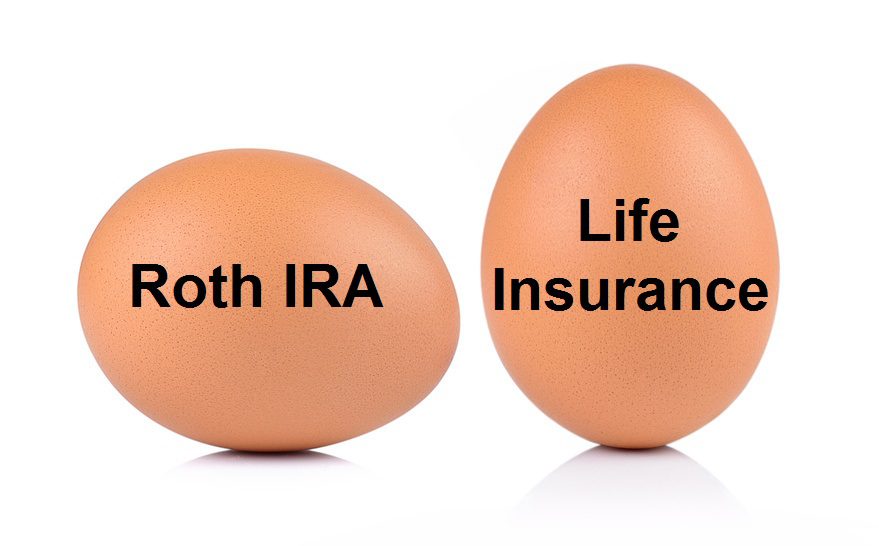Roth IRA vs Life Insurance: Which Is Best for Retirement?

In a few ways, a Roth IRA and life insurance share some similarities. They both receive tax-advantaged treatment in the IRS code. They enable efficient wealth transfers from one generation to another, and they can provide a tax-free legacy. But despite these similarities, Roth IRAs and life insurance are very different.
For one, a Roth IRA is a retirement plan while life insurance is, well, just that – an insurance product. Yet some people have been asking which of these options might be the “better” retirement planning vehicle.
However, it isn’t an “either-or” question, but rather a matter of what makes sense for each person based on their individual needs, goals, and overall financial picture. That may include planning situations in which a life insurance policy is used as a tax-advantaged growth and income vehicle alongside a Roth IRA. And maybe even some other retirement accounts!
Nevertheless, it’s important to understand the differences between a Roth IRA and life insurance – including ways the rules may apply differently to them. With that said, here’s a quick look at these two options.
Roth IRAs and Life Insurance — Some Important Differences
Roth IRAs come with more limits for contributions than life insurance does for premium payments. Let’s say someone chooses to have a Roth IRA and a cash value life insurance policy as part of their retirement savings picture. In the IRS tax code, life insurance has less restrictions than a Roth IRA does. Consider the restrictions on Roth IRA contributions, for example. Each tax year, annual contributions to a Roth IRA account are capped at a certain amount person. If you are aged 50 or older, you have a contribution limit that enables “catch-up” contributions but only goes so far.
Then there is the matter of income phase-out range. Depending on how much much in modified annual gross income they have for the tax year, married couples may only be able to contribute up to a certain amount to a Roth IRA. Or they may not even be able to at all. For those with a modified AGI above a certain level, contributions are completely out. These amounts are set each tax year by the IRS. These same principles of the income phase-out range also apply to single persons as well.
However, this isn’t the case with life insurance. Under the IRS tax code, you may buy as much insurance as you want, or rather that you can buy. There are also no restrictions on your income amount or how much insurance you “need” to purchase. Note, though, that this doesn’t mean an insurance carrier will not limit how much insurance you can get. That can depend on a number of variables for the insurance carrier, including your net-worth, the value of your investable assets, your health condition, and your yearly income. However, having a higher annual income may qualify you for even more life insurance, if you so choose.
You have fewer money sources you can use for contributions to a Roth IRA. The tax code also doesn’t pose any restrictions on the type of income you can use to buy life insurance. Life insurance premiums can be paid with any income source, including Social Security payments, dividends, interest, bank deposits, and so on. Contrastingly, annual Roth IRA contributions do come with some restrictions on money sources. Roth IRA contributions must come from income that qualifies as “compensation.” Generally speaking, this tends to be earned income.
Going back to life insurance, it doesn’t matter if a contract is paid with a lump-sum premium or multiple premiums over time. You can still use any income source, or even your assets for that matter, to make premium payments into a life insurance contract.
The attractiveness of cash value life insurance for retirement may be affected by your insurability. This is obvious, but as an insurance product, life insurance has the downside of being affected by your insurability. Personal conditions such as age, height and weight, family history, health status, lifestyle, and even whether you participate in “risky” hobbies like scuba driving or world travel will affect your life insurance rates.
Based on these actuarial variables, the insurance company may be assuming more risk. So, if that is the case, your premium payments may be outside of what you are monetarily committed to putting toward a contract. In contrast, a Roth IRA has no such considerations for its annual contributions.
The tax benefits of a life insurance policy can be affected by how much money you fund the policy with. With life insurance, it’s also important to be aware of modified endowed contracts. With legislation passed by Congress in the 1980s, some federal laws can affect the tax benefits of cash value withdrawals. Under these laws, there are limits on how much money you can use to fund a life insurance policy.
If the total sum of your premium payments exceeds the specific amounts permitted within the IRS tax code, the life insurance policy becomes a “modified endowment contract.” Should that happen, the IRS no longer treats your policy as life insurance. The death benefit for beneficiaries will be income tax-free, but cash value withdrawals will be subject to ordinary income taxes. As a result, the policy will lose its value as a vehicle for a tax-free income stream.
This article doesn’t talk about the ins-and-outs of modified endowment contracts. But you can think of an MEC as a non-qualified annuity for tax purposes. Just like with tax-deferred retirement accounts, if you take withdrawals from a modified endowment contract before age 59.5, they can be subject to an early withdrawal penalty. You likely will be hit with a 10% penalty on top of ordinary income taxation.
Note, there are ways to structure life insurance policies so you can avoid this possibility.
In estate planning, Roth IRAs are always included as part of an estate. As an individual retirement savings plan, a Roth IRA will always be part of an estate. So it will be included as part of the estate valuation. Most families won’t reach the federal exemption amount for estate taxes. But if yours does, your beneficiaries will have to pay federal estate taxes on what would otherwise be “tax-free” estate property.
Some states do have estate taxation laws. Among them, some states do have lower exemption amounts than the lofty exemption amount at the federal level. Be sure to review the tax laws of your state, advisably with guidance from an estate planning attorney and a tax professional.
On the other hand, life insurance can be structured so it remains outside of an estate. So not only will life insurance proceeds be free of estate taxes, no matter your estate’s valuation when you die, but it can deliver income tax-free benefits, too! You can also bypass probate, which can cost as much as 3-7% of your estate value. A number of strategies can be used to accomplish this, including using an irrevocable trust to buy the policy. Again, confer with knowledgeable estate planning and tax planning professionals for guidance. An experienced financial professional can help you with finding the most efficient life insurance policy options, too.
Have a Retirement or Estate Planning Question?
Get Free Feedback with No Obligation
CLICK HERE to Send Us Your QuestionIn some areas, life insurance may have more favorable tax code treatment. We already discussed how a life insurance policy can be a truly tax-free estate planning benefit. There is yet another tax code advantage for beneficiaries. Should you pass on a Roth IRA to a beneficiary or to beneficiaries who isn’t (or aren’t) not your spouse, required minimum distributions will kick in. Generally speaking, they will be required to start taking RMDs a year after they inherited the Roth IRA. However, those distributions can be tax-free.
With the SECURE ACT being passed in recent years, distributions to heirs from IRAs and Roth IRAs have changed. These changes can be pretty complicated, so make sure to consult with experienced estate planning as well as financial professionals if you have questions about your personal situation.
In contrast, your beneficiaries have no required minimum distributions imposed on life insurance. That eliminates the hassle of having to deal with minimum withdrawal requirements year to year.
Another benefit for life insurance isn’t found in the distribution stage, but the purchasing stage. If a business purchases a life insurance policy, under certain conditions premium payments may be tax-deductible. Because a Roth IRA is an after-tax retirement plan, tax-deducting advantages don’t apply. Be sure to seek guidance from a qualified tax professional for more information.
Need Help with Putting an Efficient Retirement Plan Together?
These are ways that Roth IRAs and life insurance differ, but they are just a few. No matter what your configuration of retirement accounts, insurance contracts, investments, and personal savings is, it should be right for you. Work with a qualified financial professional who acts in your best interest and can help you find options that make sense for your needs, goals, and situation.
Should you be ready for personal guidance in creating a tax-efficient and reliable plan for income and safe growth in retirement, financial professionals at SafeMoney.com stand ready to help you.
Use our “Find a Financial Professional” to connect with someone for a no-obligation consultation. And to request a personal referral, call us at 877.476.9723.








